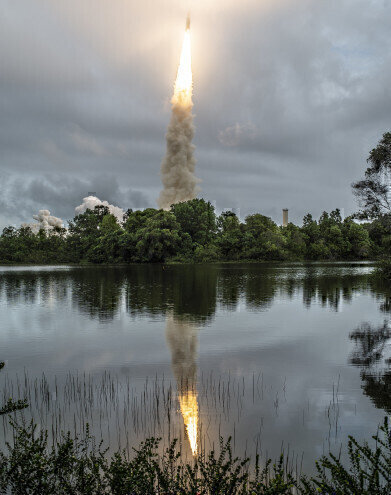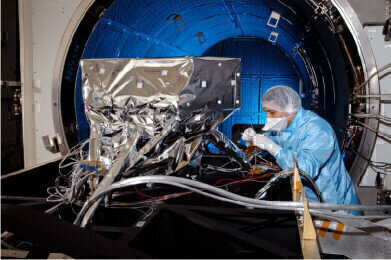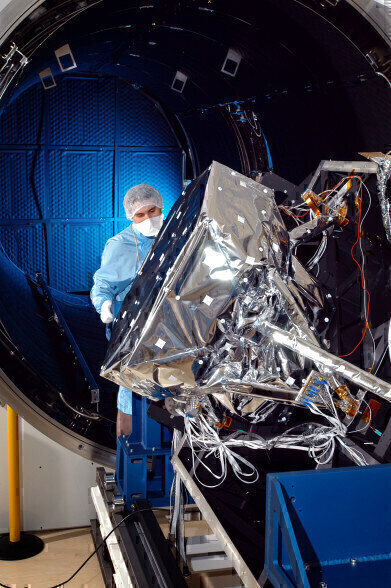-
 Webb was launched on an ArianeSpace Ariane 5 Launch Vehicle on December 25, 2021. Credit: NASA/Chris Gunn
Webb was launched on an ArianeSpace Ariane 5 Launch Vehicle on December 25, 2021. Credit: NASA/Chris Gunn -
 RAL Space Chief Engineer Paul Eccleston working on MIRI (Credit: STFC)
RAL Space Chief Engineer Paul Eccleston working on MIRI (Credit: STFC) -

News & Views
Webb set to Reveal new Secrets of the Universe
Jan 28 2022
International scientific and engineering communities celebrated a special Christmas event when the James Webb Telescope (Webb), described as a once-in-a-generation spacecraft, successfully blasted off from Europe’s spaceport in Kourou, French Guiana - the culmination of decades of scientific collaboration.
The project, led by NASA, the European Space Agency (ESA) and the Canadian Space Agency, the UK played a major role by leading the European Consortium which, partnered with US institutes, designed, built and tested one of the four main science instruments.
Scientists and engineers in the UK and Ireland were part of the team that oversaw the development and launch of the Mid-Infrared Instrument (MIRI), which will be able to see the faint light from the most distant stars and peer through dust and gas to spot stars being born.
Led by Professor Gillian Wright MBE of STFC’s UK Astronomy Technology Centre (UKATC), and including STFC RAL Space, University of Leicester and Airbus UK, MIRI will deliver a host of capabilities, boasting a spectrograph to break up light into its constituent wavelengths, a coronagraph to block starlight and look at fainter objects next to stars, and a camera to take pictures.
Throughout the project the UK’s lead role was the responsibility for the overall design, science performance and the mechanical, thermal and optical design, along with the assembly, integration, testing and calibration software.
Rising to the Challenge
Professor Gillian Wright, European Principal Investigator for MIRI and Director of UKATC, said: “To see Webb launch, with MIRI on board, after more than two decades is a seminal moment.
“MIRI is a special instrument, for the breadth of its science, the team that built it and being the coolest instrument on Webb. The MIRI team rose to the challenges and brought some exquisite engineering solutions to make it a reality. The Webb mission as a whole is an amazing technological breakthrough in scale and complexity, and this extends to the instruments, including MIRI. With the launch, all of us are excitedly anticipating the first MIRI data and the new view of the universe we will have.”
The Irish contribution to the project included providing the infrared filters on one of the telescopes four instruments and the corresponding imaging software, the onboard video system to monitor successful separation of the telescope from the launcher, and structural supports for the engine that powers the Ariane 5 rocket.
Professor Tom Ray of DIAS is Co-Investigator for the Mid-InfraRed Instrument (MIRI), part of the telescope’s instrument suite. Out of the four instruments, MIRI is the only one covering the mid-infrared wavelength range (from 5 to 28.3 microns). MIRI will produce mid-infrared images and spectra with an unprecedented combination of sharpness and sensitivity.
Professor Ray’s team were responsible for providing MIRI’s infrared filters, which breaks up the light into its various components, and also for developing imaging software that will be used to analyse the instrument data sent back to Earth by the spacecraft and produce scientific images.
Réaltra Space Systems Engineering designed and manufactured the video system mounted on the Ariane 5 launch vehicle which relayed high-definition video images of the separation of the launcher’s fairing (that encloses and protects the Webb telescope during launch) and of the telescope separation as it headed on the start of the journey to its final orbit location. This is the first time the video system has been used, having originally been developed for the Ariane 6 launch vehicle, the successor to Ariane 5, due for its first flight in 2022.
Nammo Ireland also provided structural supports for the Vulcain engine that powers Ariane 5, and will also manufacture components for both the Vulcain and Vinci engines on the new Ariane 6 launch vehicle.
The participation of DIAS, Réaltra Space Systems Engineering and Nammo Ireland in the Webb mission is enabled through Ireland’s membership of ESA. Ireland manages its investment in space primarily through the Department of Enterprise, Trade and Employment (DETE) and Enterprise Ireland, which supports and guides Irish industry and research institutes in developing technologies through ESA programmes, and in commercialising these technologies in the worldwide space market.
UK Science Minister George Freeman said that the launch was “a monumental milestone for international and UK space science: the Webb Space Telescope will allow us to go further and deeper to explore and discover our planetary universe. The project draws heavily on the world-class expertise of top UK scientists and engineers who were able to deliver vital pieces of this complex and powerful telescope.”
Webb will look back in time, closer to the beginning of the formation of stars and galaxies than ever before, to determine how the first galaxies formed.
Damien English TD, Ireland’s Minister of State for Business, Employment and Retail, congratulated the Dublin Institute for Advanced Studies (DIAS) and Irish companies, Réaltra Space Systems Engineering and Nammo Ireland for their contributions to the Webb Space Telescope mission: “It was wonderful to see the successful launch of the James Webb Space Telescope, with images of the spacecraft starting its long journey streamed back to Earth by Irish technology and relayed around the world. I also eagerly anticipate the ground-breaking science that will be enabled by Webb, with Irish scientists at the heart of uncovering the secrets of the formation of our Universe.”
Leo Clancy, CEO, Enterprise Ireland, congratulated the companies and scientists involved in the mission, noting that Ireland can be justifiably proud of its world-class scientific and technical capabilities in space science. “Irish companies have consistently shown that they can deliver innovative technologies to the space sector. Webb is the most ambitious space mission for many years, if not decades, and it is fitting that Ireland has played such a prominent role in the Ariane 5 launch, and also in the scientific instruments on the telescope itself.”
Caroline Harper, Head of Space Science at the UK Space Agency, said:
“Webb is set to re-write the text books on astronomy, showing us things about the universe we have never been able to see before. I am excited to see the fascinating discoveries the spacecraft makes as it reveals the evolution of the universe.
Webb in space
The giant mirror for the telescope had to be launched as 18 segments folded inside the launch vehicle and the first step in space was to achieve bot the unfolding and perfect alignment of all of the segments. A huge sunshield the size of a tennis court is needed to keep the instruments cold enough to work and this must also be unfurled in space.
Webb will then go on a month-long journey to its destination, a million miles from Earth. In the six months after launch, the observatory commissioning will take place – with first results expected in the summer of 2022.
Digital Edition
Lab Asia 31.2 April 2024
April 2024
In This Edition Chromatography Articles - Approaches to troubleshooting an SPE method for the analysis of oligonucleotides (pt i) - High-precision liquid flow processes demand full fluidic c...
View all digital editions
Events
Apr 28 2024 Montreal, Quebec, Canada
May 05 2024 Seville, Spain
InformEx Zone at CPhl North America
May 07 2024 Pennsylvania, PA, USA
May 14 2024 Oklahoma City, OK, USA
May 15 2024 Birmingham, UK

















